Assessment Workbook-1: CHC30113 Certificate III in Early Childhood
Added on 2022-11-16
134 Pages20661 Words26 Views
CHC30113 Certificate III in Early Childhood Education and Care
Children’s Health and Safety
Version 3.7Produced17September2018
Copyright©2018CompliantLearningResources.Allrights reserved. No part of this
publicationmaybereproducedordistributedinanyform orbyany means,
orstoredinadatabaseorretrieval system otherthanpursuant to the terms of the
CopyrightAct1968 (Commonwealth),withoutthepriorwrittenpermissionof
Compliant Learning Resources
Assessment
Children’s Health and Safety
Version 3.7Produced17September2018
Copyright©2018CompliantLearningResources.Allrights reserved. No part of this
publicationmaybereproducedordistributedinanyform orbyany means,
orstoredinadatabaseorretrieval system otherthanpursuant to the terms of the
CopyrightAct1968 (Commonwealth),withoutthepriorwrittenpermissionof
Compliant Learning Resources
Assessment

Assessment
Workbook 1
Page 2
Version No.3.4 Produced7 February
2018
© Compliant LearningResources
Version control & document history
Date Summary of modifications made Version
9 December 2013 Version1finalproducedfollowing
assessmentvalidation.
1.0
16 April2014 Changes to wording and clarification of
benchmarks in questions.
A1,A3a,b,A14,A25,B10,C10
1.1
24 October 2014 Minor clarifications inquestionsA14;
removed B8(a)questionsimilarwith B7(d) 1.2
18November 2014 Changes made throughout document 1.3
3 December 2014 Significant changes made to document
following validation
2.0
17April2015 Minor revisions onQuestionsB1and B16 2.1
18 July2016 Updates made throughout document 2.2
9 August2016 Included CHCECE016
intheunitsofcompetency
ofthisworkbook.
Added assessment items in the Project.
3.0
9 March2017 Minor changes in formatting and wording
throughout document
3.1
14 March2017 Updated links throughout the document 3.2
8 January2018 Mademinor revisions
totaskinstructionsand
emailtemplateinCaseStudies –Part B–
CaseStudy2
3.3
7 February2018 Updated Part B Question 8d 3.4
Workbook 1
Page 2
Version No.3.4 Produced7 February
2018
© Compliant LearningResources
Version control & document history
Date Summary of modifications made Version
9 December 2013 Version1finalproducedfollowing
assessmentvalidation.
1.0
16 April2014 Changes to wording and clarification of
benchmarks in questions.
A1,A3a,b,A14,A25,B10,C10
1.1
24 October 2014 Minor clarifications inquestionsA14;
removed B8(a)questionsimilarwith B7(d) 1.2
18November 2014 Changes made throughout document 1.3
3 December 2014 Significant changes made to document
following validation
2.0
17April2015 Minor revisions onQuestionsB1and B16 2.1
18 July2016 Updates made throughout document 2.2
9 August2016 Included CHCECE016
intheunitsofcompetency
ofthisworkbook.
Added assessment items in the Project.
3.0
9 March2017 Minor changes in formatting and wording
throughout document
3.1
14 March2017 Updated links throughout the document 3.2
8 January2018 Mademinor revisions
totaskinstructionsand
emailtemplateinCaseStudies –Part B–
CaseStudy2
3.3
7 February2018 Updated Part B Question 8d 3.4

Assessment Workbook 1
© Compliant Learning
Resources
Version No.3.7Produced17 September
2018
Page3
21May2018 NQS Updates 3.5
29 May2018 Updated Meal Template 3.6
17September 2018 updatedKnowledgeAssessmentPartAQues
tion19f 3.7
© Compliant Learning
Resources
Version No.3.7Produced17 September
2018
Page3
21May2018 NQS Updates 3.5
29 May2018 Updated Meal Template 3.6
17September 2018 updatedKnowledgeAssessmentPartAQues
tion19f 3.7
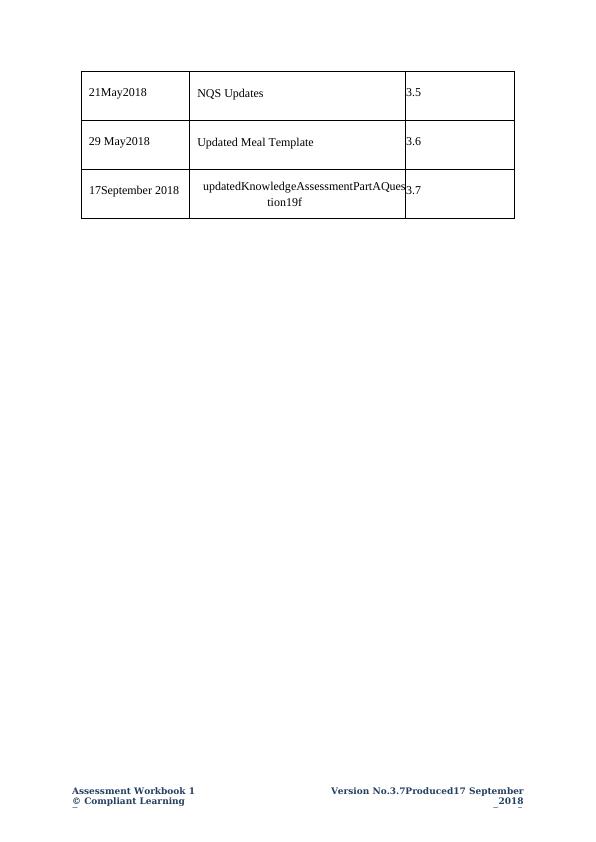
Assessment
Workbook 1
Page 4
Version No.3.7Produced17 September
2018
© Compliant LearningResources
TABLE OFCONTENTS
This is an interactive table of contents. If you are viewing this document in Acrobat, clicking
on a heading will transfer you to that page. If you have this document open in Word, you will
need to hold down the Control key while clicking for this to work.
INSTRUCTIONS.....................................................................................................................5
WHAT IS COMPETENCYBASEDASSESSMENT............................................................6
THE BASIC PRINCIPLES OF ASSESSING NATIONALLY
RECOGNISEDTRAINING....................................................................................................7
THE DIMENSIONSOFCOMPETENCY.............................................................................8
REASONABLEADJUSTMENT............................................................................................9
CHEATINGANDPLAGIARISM.........................................................................................11
THEUNITSOF COMPETENCY.........................................................................................12
CONTEXTFORASSESSMENT..........................................................................................17
ASSESSMENTMETHODS.................................................................................................18
RESOURCES REQUIREDFORASSESSMENT..............................................................18
PRESENTATION.................................................................................................................19
ASSESSMENTWORKBOOKCOVERSHEET ...............................................................20
KNOWLEDGEASSESSMENT...........................................................................................21
CASE STUDIES –PARTA..................................................................................................95
CASE STUDIES –PARTB.................................................................................................101
PROJECT: ESTABLISH AND MAINTAIN A SAFE AND HEALTHY
ENVIRONMENTFORCHILDREN.................................................................................118
WORKBOOKCHECKLIST ............................................................................................129
REQUIREDDOCUMENTS..............................................................................................130
Workbook 1
Page 4
Version No.3.7Produced17 September
2018
© Compliant LearningResources
TABLE OFCONTENTS
This is an interactive table of contents. If you are viewing this document in Acrobat, clicking
on a heading will transfer you to that page. If you have this document open in Word, you will
need to hold down the Control key while clicking for this to work.
INSTRUCTIONS.....................................................................................................................5
WHAT IS COMPETENCYBASEDASSESSMENT............................................................6
THE BASIC PRINCIPLES OF ASSESSING NATIONALLY
RECOGNISEDTRAINING....................................................................................................7
THE DIMENSIONSOFCOMPETENCY.............................................................................8
REASONABLEADJUSTMENT............................................................................................9
CHEATINGANDPLAGIARISM.........................................................................................11
THEUNITSOF COMPETENCY.........................................................................................12
CONTEXTFORASSESSMENT..........................................................................................17
ASSESSMENTMETHODS.................................................................................................18
RESOURCES REQUIREDFORASSESSMENT..............................................................18
PRESENTATION.................................................................................................................19
ASSESSMENTWORKBOOKCOVERSHEET ...............................................................20
KNOWLEDGEASSESSMENT...........................................................................................21
CASE STUDIES –PARTA..................................................................................................95
CASE STUDIES –PARTB.................................................................................................101
PROJECT: ESTABLISH AND MAINTAIN A SAFE AND HEALTHY
ENVIRONMENTFORCHILDREN.................................................................................118
WORKBOOKCHECKLIST ............................................................................................129
REQUIREDDOCUMENTS..............................................................................................130
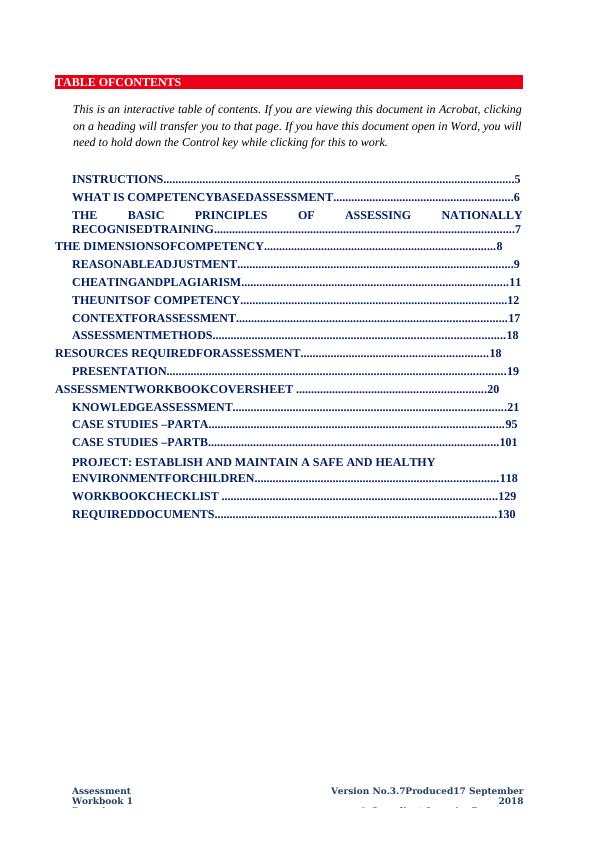
Assessment Workbook 1
© Compliant Learning
Resources
Version No.3.7Produced17 September
2018
Page5
INSTRUCTIONS
The questions in the Knowledge Assessment are all in a short answer format. They
addresstheunderpinningknowledgeandconceptsrelevanttotheunitsofcompetency in thissubject.
CaseStudiesarelongerquestionsrequiringcreativethoughtprocessesandapplication of concepts
to theoretical situations, while the Project sets out tasks to be delivered in an actual
workplacesetting.
Where applicable, you must answer all questions using your own words. However you
may reference your learner guide, and other online or hard copy resources to complete this
assessment.
You must attempt all assessments satisfactorily to achieve an overall award of competent.
Re-read the section on Plagiarism and Copying in your Welcome pack.
IfyouarecurrentlyworkingaspartofanEarlyChildhoodEducation/ChildCareteam, you may
answer these questions based on your own workplace. Otherwise consider
whatyoushoulddoifyouwereworkingaspartofanEarlyChildhoodEducation/Child Care team
you may refer to Sparkling Stars as anexample.
© Compliant Learning
Resources
Version No.3.7Produced17 September
2018
Page5
INSTRUCTIONS
The questions in the Knowledge Assessment are all in a short answer format. They
addresstheunderpinningknowledgeandconceptsrelevanttotheunitsofcompetency in thissubject.
CaseStudiesarelongerquestionsrequiringcreativethoughtprocessesandapplication of concepts
to theoretical situations, while the Project sets out tasks to be delivered in an actual
workplacesetting.
Where applicable, you must answer all questions using your own words. However you
may reference your learner guide, and other online or hard copy resources to complete this
assessment.
You must attempt all assessments satisfactorily to achieve an overall award of competent.
Re-read the section on Plagiarism and Copying in your Welcome pack.
IfyouarecurrentlyworkingaspartofanEarlyChildhoodEducation/ChildCareteam, you may
answer these questions based on your own workplace. Otherwise consider
whatyoushoulddoifyouwereworkingaspartofanEarlyChildhoodEducation/Child Care team
you may refer to Sparkling Stars as anexample.
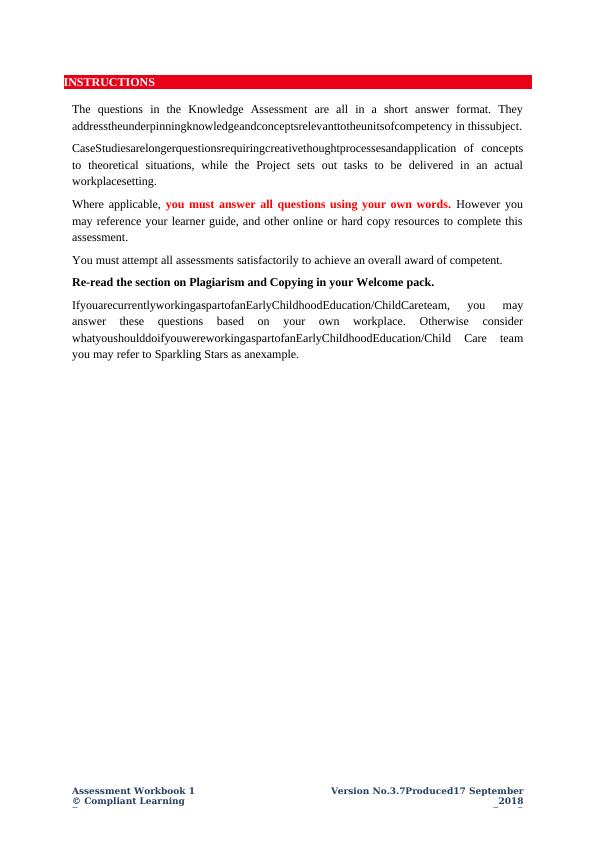
Assessment
Workbook 1
Page 6
Version No.3.7Produced17 September
2018
© Compliant LearningResources
WHAT IS COMPETENCY BASEDASSESSMENT
The features of a competency based assessment system are:
It is focused on what learners can do and whether it meets the criteria specified by
industry as competencystandards.
Assessmentshouldmirrortheenvironmentthelearnerwillencounterinthe workplace.
Assessment criteria should be clearly stated to the learner at the beginning of the
learningprocess.
Assessment should be holistic. That is it aims to assess as many elements and/or
units of competency as is feasible at onetime.
In competency assessment a learner receives one of only two outcomes –
competent or not yetcompetent.
The basis of assessment is in applying knowledge for some purpose. In a
competency system, knowledge for the sake of knowledge is seen to be ineffectual
unless it assists a person to perform a task to the level required in theworkplace.
The emphasis in assessment is on assessable outcomes that are clearly stated for
the trainer and learner. Assessable outcomes are tied to the relevant industry
competency standards where these exist. Where such competencies do not exist,
the outcomes are based upon those identified in a training needsanalysis.
Definition of competency
Assessment in this context can be defined as:
The fair, valid, reliable and flexible gathering and recording of evidence to
support judgement on whether competence has been achieved. Skills and
knowledge (developed either in a structured learning situation, at work, or in some
other context) are assessed against national standards of competence required by
industry, rather than compared with the skills and knowledge of otherlearners.
Workbook 1
Page 6
Version No.3.7Produced17 September
2018
© Compliant LearningResources
WHAT IS COMPETENCY BASEDASSESSMENT
The features of a competency based assessment system are:
It is focused on what learners can do and whether it meets the criteria specified by
industry as competencystandards.
Assessmentshouldmirrortheenvironmentthelearnerwillencounterinthe workplace.
Assessment criteria should be clearly stated to the learner at the beginning of the
learningprocess.
Assessment should be holistic. That is it aims to assess as many elements and/or
units of competency as is feasible at onetime.
In competency assessment a learner receives one of only two outcomes –
competent or not yetcompetent.
The basis of assessment is in applying knowledge for some purpose. In a
competency system, knowledge for the sake of knowledge is seen to be ineffectual
unless it assists a person to perform a task to the level required in theworkplace.
The emphasis in assessment is on assessable outcomes that are clearly stated for
the trainer and learner. Assessable outcomes are tied to the relevant industry
competency standards where these exist. Where such competencies do not exist,
the outcomes are based upon those identified in a training needsanalysis.
Definition of competency
Assessment in this context can be defined as:
The fair, valid, reliable and flexible gathering and recording of evidence to
support judgement on whether competence has been achieved. Skills and
knowledge (developed either in a structured learning situation, at work, or in some
other context) are assessed against national standards of competence required by
industry, rather than compared with the skills and knowledge of otherlearners.

Assessment Workbook 1
© Compliant Learning
Resources
Version No.3.7Produced17 September
2018
Page7
THE BASIC PRINCIPLES OF ASSESSING
NATIONALLY RECOGNISED TRAINING
Developing and conducting assessment, in an Australian vocational education and training
context, is founded on a number of basic conventions:
The principles of assessment
Assessment must bevalid
o Assessment must include the full range of skills and knowledge needed to
demonstratecompetency.
o Assessment must include the combination of knowledge and skills with
their practicalapplication.
o Assessment, where possible, must include judgements based on evidence
drawn from a number of occasions and across a number of contexts.
Assessment must bereliable
o Assessment must be reliable and must be regularly reviewed to ensure that
assessors are making decisions in a consistentmanner.
o Assessors must be trained in national competency standards for assessors
to ensurereliability.
Assessment must beflexible
o Assessment, where possible, must cover both the on and off-the-job
components of training within acourse.
o Assessmentmustprovidefortherecognitionofknowledge,skillsand attitudes
regardless of how they have beenacquired.
o Assessment must be made accessible to learners though a variety of
delivery modes, so they can proceed through modularised training
packages to gaincompetencies.
Assessment must be fair andequitable
o Assessment must be equitable to all groupsoflearners.
o Assessment procedures and criteria must be made clear to all learners
beforeassessment.
o Assessment must be mutually developed and agreed upon between
assessor and theassessed.
o Assessment must be able to be challenged. Appropriate mechanisms must
be made for reassessment as a result ofchallenge.
© Compliant Learning
Resources
Version No.3.7Produced17 September
2018
Page7
THE BASIC PRINCIPLES OF ASSESSING
NATIONALLY RECOGNISED TRAINING
Developing and conducting assessment, in an Australian vocational education and training
context, is founded on a number of basic conventions:
The principles of assessment
Assessment must bevalid
o Assessment must include the full range of skills and knowledge needed to
demonstratecompetency.
o Assessment must include the combination of knowledge and skills with
their practicalapplication.
o Assessment, where possible, must include judgements based on evidence
drawn from a number of occasions and across a number of contexts.
Assessment must bereliable
o Assessment must be reliable and must be regularly reviewed to ensure that
assessors are making decisions in a consistentmanner.
o Assessors must be trained in national competency standards for assessors
to ensurereliability.
Assessment must beflexible
o Assessment, where possible, must cover both the on and off-the-job
components of training within acourse.
o Assessmentmustprovidefortherecognitionofknowledge,skillsand attitudes
regardless of how they have beenacquired.
o Assessment must be made accessible to learners though a variety of
delivery modes, so they can proceed through modularised training
packages to gaincompetencies.
Assessment must be fair andequitable
o Assessment must be equitable to all groupsoflearners.
o Assessment procedures and criteria must be made clear to all learners
beforeassessment.
o Assessment must be mutually developed and agreed upon between
assessor and theassessed.
o Assessment must be able to be challenged. Appropriate mechanisms must
be made for reassessment as a result ofchallenge.
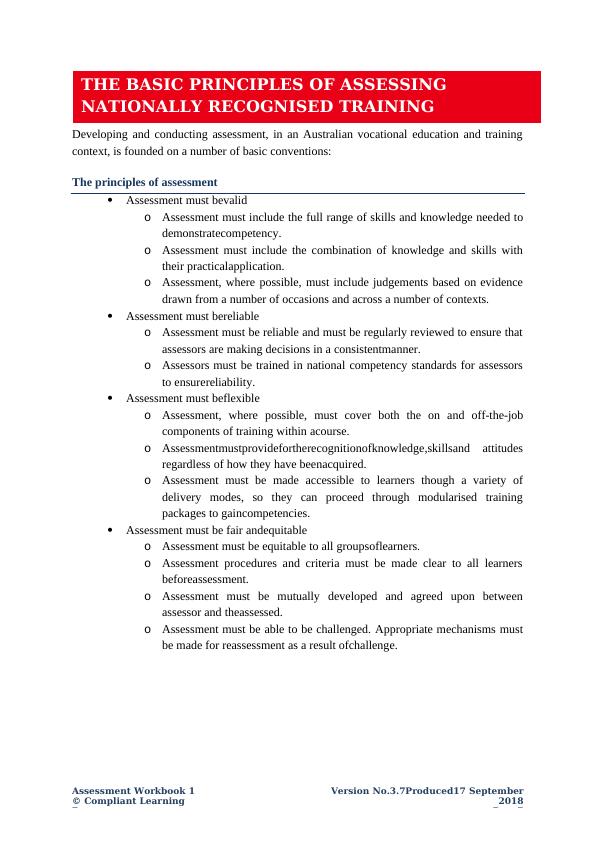
Assessment
Workbook 1
Page 8
Version No.3.7Produced17 September
2018
© Compliant LearningResources
The rules of evidence (from Training in Australia by M Tovey, D Lawlor)
When collecting evidence there are certain rules that apply to that evidence. All evidence
must be valid, sufficient, authentic and current;
Valid
o Evidence gathered should meet the requirements of the unit of
competency. This evidence should match, or at least reflect, the type of
performance that is to be assessed, whether it covers knowledge, skills
orattitudes.
Sufficient
o This rule relates to the amount of evidence gathered. It is imperative
thatenoughevidenceisgatheredtosatisfytherequirementsthatthe learner is
competent across all aspects of the unit ofcompetency.
Authentic
o When evidence is gathered, the assessor must be satisfied that evidence is
the learner’s ownwork.
Current
o This relates to the recency of the evidence and whether the evidence
relates to currentabilities.
THE DIMENSIONS OFCOMPETENCY
Thenationalconceptofcompetencyincludesallaspectsofworkperformance,andnot only narrow task
skills. The four dimensions of competencyare:
Taskskills
Task managementskills
Contingency managementskills
Job role and environmentskills
Workbook 1
Page 8
Version No.3.7Produced17 September
2018
© Compliant LearningResources
The rules of evidence (from Training in Australia by M Tovey, D Lawlor)
When collecting evidence there are certain rules that apply to that evidence. All evidence
must be valid, sufficient, authentic and current;
Valid
o Evidence gathered should meet the requirements of the unit of
competency. This evidence should match, or at least reflect, the type of
performance that is to be assessed, whether it covers knowledge, skills
orattitudes.
Sufficient
o This rule relates to the amount of evidence gathered. It is imperative
thatenoughevidenceisgatheredtosatisfytherequirementsthatthe learner is
competent across all aspects of the unit ofcompetency.
Authentic
o When evidence is gathered, the assessor must be satisfied that evidence is
the learner’s ownwork.
Current
o This relates to the recency of the evidence and whether the evidence
relates to currentabilities.
THE DIMENSIONS OFCOMPETENCY
Thenationalconceptofcompetencyincludesallaspectsofworkperformance,andnot only narrow task
skills. The four dimensions of competencyare:
Taskskills
Task managementskills
Contingency managementskills
Job role and environmentskills
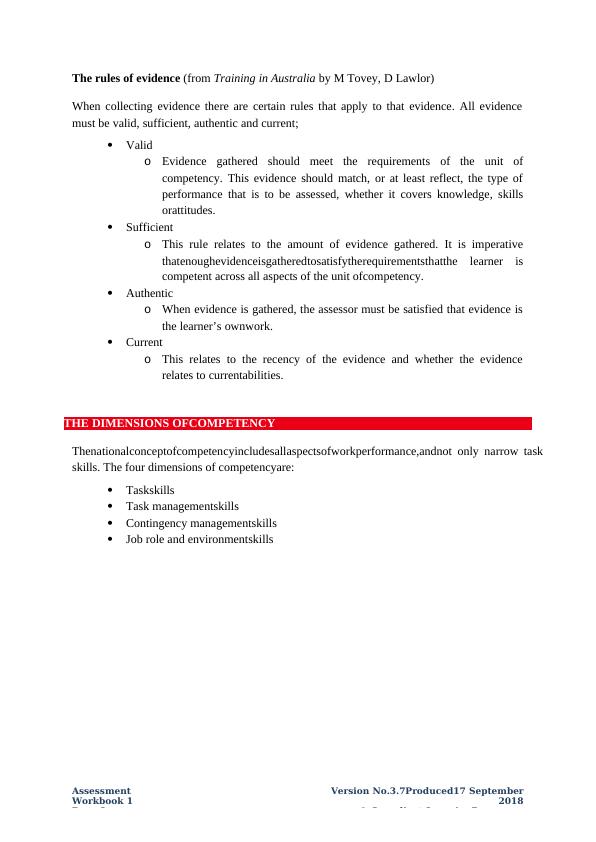
End of preview
Want to access all the pages? Upload your documents or become a member.
Related Documents
Compliant Learning Resources Version control & document hh: A Certificate III in Early Childhood Education and Care Childrens Health and Safety Version 3.7 Produced 17 September 2018lg...
|91
|23021
|404
CHC30113 Certificate III In Early Childhood Education And Care - Assessment 1lg...
|164
|33081
|31
Compliant Learning Resources (CHC30113 Certificate III in Early Childhood Education and Care Children’s Health and Safety V3.0 Produced 9 August 2016lg...
|141
|16852
|260
Children’s Health and Safety in Early Childhood Education and Carelg...
|151
|24108
|457
Compliant Learning Resources Assessment Workbook 1 CHC30113 Certificate III Versio 3.7 Produced 17 September 2018lg...
|157
|30772
|380
Children’s Health and Safety Assessment Workbook 1 for CHC50113lg...
|131
|17600
|166
